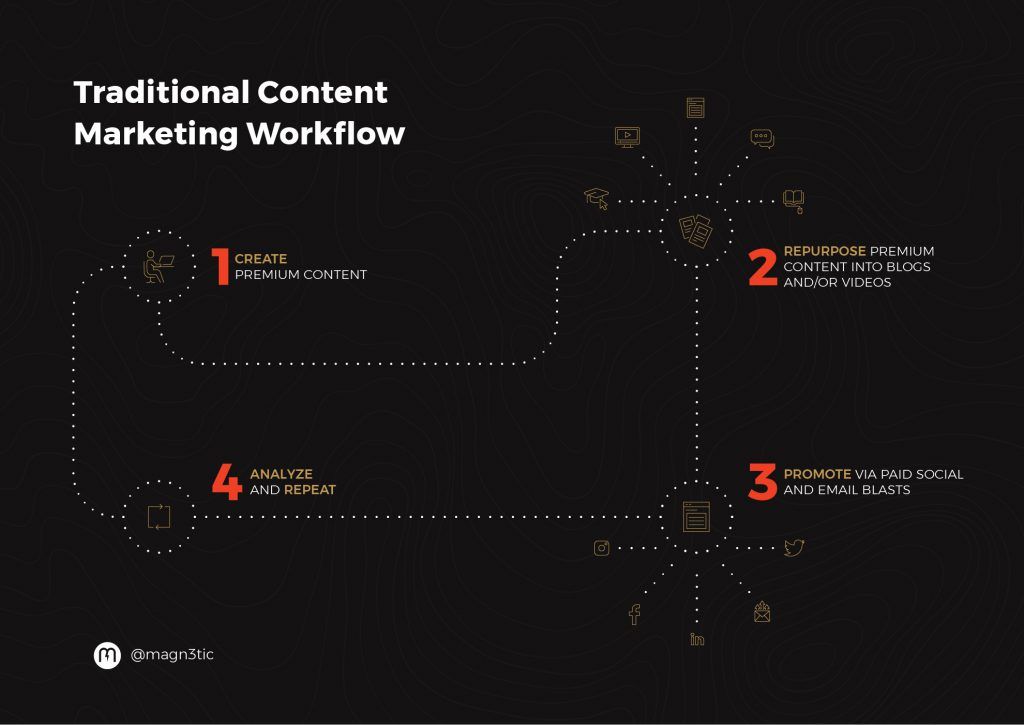Today, I’ll share an idea that’s been in the back of my mind for a few months now regarding how B2B brands tend to structure their content marketing workflow.
As we all know, there’s been a massive explosion in branded content over the past few years. But only a handful of brands can repeatedly create content that performs and continues to deliver value over a long stretch of time – especially without being entirely dependent on paid media for distribution and reach.
So why is this? Do businesses not have a natural inclination for storytelling and audience development?
My hypothesis is that for most brands, a fatal misstep occurs well before pen ever touches paper. In other words, it isn’t the execution of content that’s the problem, but rather the approach.
Let’s review the traditional content marketing workflow
Note: This article is intended for marketers who have already invested in content creation and have at least partially defined a repeatable workflow to ideate and execute new content marketing ideas. If you’re starting from scratch (meaning you have zero content), I’d urge you to take a step back and begin by defining your brand’s “why”. Around here, we refer to that as your True North
The Traditional Content Marketing Workflow
The “traditional” approach that many brands follow to create content for an inbound marketing campaign is fairly straightforward:
- Create your “premium” content. This is typically some kind of eBook, whitepaper, or webinar that’s gated behind a lead capture form. (On a side note, gating content might not always be your best bet. For more on that topic, check out this Whiteboard Friday from our friends at Moz).
- Repurpose that premium content into a series of blogs and/or videos, which can then be distributed via email and social media. We like to use the “Thanksgiving Analogy”. You begin with a wonderful feast (your premium content), then in the following days, you repurpose that feast into turkey sandwiches, stews, and all kinds of other tasty leftovers (i.e. blogs, videos, social posts, etc.).
- Once all of this content goes live, it’s then typically promoted via paid social and distributed to an email subscriber-ship. That is, until the focus shifts over to the next shiny, new campaign and the promotion budget is reallocated.

Don’t get me wrong, this workflow is solid. It’s logical, efficient, and theoretically, all of your content will be tightly aligned topically. Thus, capable of driving traffic back to your landing page. We often follow this very framework here at Magnetic Creative and our clients have seen fantastic results.
But, if you’re not careful, pulling top-of-funnel content ideas out of a piece of premium content can lead to two key issues:
- Your creative pieces (blogs, video, etc.) essentially become “watered down” versions of the original premium content—all in an attempt to manipulate the user to click through to the landing page. Do the watered down versions really provide value? Rarely. And if they aren’t valuable, they’re useless.
- To compound that, the top-of-funnel content is rarely targeted around long-tail keywords with organic traffic. If the blogs you create don’t rank organically, the campaign will fully depend on paid media for distribution. This doesn’t give you the opportunity for exponential, organic growth. Once your budget runs out, the content will die off. Sad face!
Related Reading:
Content Audit: Automate Your Website Evaluation [Video + Free Template]
The Agile Content Marketing Workflow
Instead of investing intensive time and resources into one piece of premium content that may or may not perform, what if we viewed the blog as a proof of concept? By enabling our audience to show us what they care about, we can then create powerful content upgrades to drive conversions and nurture the user’s relationship with the brand.
What I mean by that is, let’s:
- Map out your personas to define key, topical “buckets” and where they fall in the buyer’s journey.
- Build out a keyword research list that aligns keyword search volume and competition with the topical research from step 1.
- Create blogs around strategically targeted long-tail keywords with decent organic volume and relatively low competition.
- Experiment to determine which blogs see social and/or organic traction, and then create specific content offers to capitalize.
See the difference?
In the agile example, we’re creating a higher volume of diverse, top-of-funnel content, identifying which blogs receive organic and social traction, and then investing in a killer content upgrade. Let’s operate on precision rather than chance. In this approach, our audience essentially tells us what they want, which in turn removes the guesswork from content creation.
*If you’re a Hubspot user, I recommend checking out our HubSpot Portal Audit*
Agile Content Marketing: Drive Results by Focusing On What Actually Works
If it sounds like common sense, well it is. I’ll elaborate with an example from our own site.
Over the last year, Magnetic Creative’s site gained significant organic traction as a result of a few instructional Instagram blogs. How did we capitalize on that traffic?
In a few days, we created a free set of Creative Instagram Templates, added CTAs on the end of each high-performing blog, plus we began retargeting that blog traffic with paid social for additional conversions. We then incorporated other existing, topically-related blogs into an email delivery workflow for further lead nurture.
How this change in content strategy impacts conversions on our premium content offering
This instantly gave us predictable click-through traffic and consistent conversions without needing to rely on paid promotion. Sure, we added retargeting to boost conversions, but we didn’t have to. The organic click through rate alone was substantial.

The best part? Now that we’re growing leads organically, we can focus our efforts on new content because this method will continue to deliver over time.
Now, I’m not saying that the traditional content marketing workflow is broken—it’s not! But it isn’t perfect either. This Agile Content Marketing Workflow is a solid alternative for anyone looking to create relevant premium content that performs over a longer period of time.
When it Comes to Content, Quality Will Always Be King
Regardless of your content workflow, the most important piece to the puzzle will undoubtedly be the quality of your content.
If you feel that your writing could improve (and let’s be honest, we can all be better writers), our copy department’s Conversion Copywriting Tips to Enhance Your Content Today is a great place to start.
Looking for new ideas to give your video marketing a jolt? Give this article on Sizzle Videos a read. It’s packed with actionable tips and tricks to get more reach and engagement out of your video marketing budget.
Want to make your Content Marketing Workflow Perfect?
Practice (and Consistency) Makes Perfect
Like any sound marketing strategy, the success of your content marketing is heavily dependent on consistency. Set an attainable content production schedule and stick to it. Schedule time to review what’s working and look for places to optimize your team’s efficiency.



Join the Discussion